Kenneth L. Gentry Jr.'s Blog, page 28
March 17, 2023
REVELATION’S BASIC JUDGMENT STRUCTURE
 PMT 2023-022 by Kenneth L. Gentry, Jr.
PMT 2023-022 by Kenneth L. Gentry, Jr.
It has been said that wherever you find five Revelation commentaries, you will discover six different Revelation outlines. Outlining Revelation is a difficult task due to its cyclical and repetitive movement. For instance, in it appear cycles of seven: seven seals, seven trumpets, and seven vials. But these appear to be rehearsing the same information.
Nevertheless, outlining Revelation is an important, though difficult, task that can be accomplished. The structuring of Revelation should emphasize its judicial character, since we see one judgment of God after another in its unfolding story.
The Structuring Device
Though Revelation may be outlined in several different ways, its most basic framework is structured around John’s four “in Spirit” (Greek: en pneumati) experiences (1:10; 4:2; 17:3; 21:10). This phraseology only appears four times in Revelation. And they highlight Revelation’s simplest, most basic structural feature, presenting the material in four primary visions, which point to four major transitions within the whole vision.
Rev 1:10 “I was in the Spirit on the Lord’s day, and I heard behind me a loud voice like the sound of a trumpet.”
Rev 4:2 “Immediately I was in the Spirit; and behold, a throne was standing in heaven, and One sitting on the throne.”
Rev 17:3 “He carried me away in the Spirit into a wilderness; and I saw a woman sitting on a scarlet beast, full of blasphemous names, having seven heads and ten horns.”
Rev 21:10 “He carried me away in the Spirit to a great and high mountain, and showed me the holy city, Jerusalem, coming down out of heaven from God.”
This simple structuring of the book picks up on this distinctive phrasing that highlights John’s prophetic experience (1:10; 4:2) and Spirit-transport (17:3; 21:10).
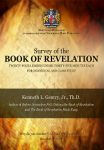
Survey of the Book of Revelation
(DVDs by Ken Gentry)
Twenty-four careful, down-to-earth lectures provide a basic introduction to and survey of the entire Book of Revelation. Professionally produced lectures of 30-35 minutes length.
See more study materials at: www.KennethGentry.com
The Structuring Result
Associated with each occurrence of the “in the Spirit” phraseology, we find John appearing in a ifferent location. Each location is radically different from the others.
In the context of Rev 1:10, we see John on the island of Patmos. In Rev 1:9 we read:
“I, John, your brother and fellow partaker in the tribulation and kingdom and perseverance which are in Jesus, was on the island called Patmos.”
In today’s context, the second “in the spirit” (Rev. 4:2) statement, we find John transported from Patmos on the earth to heaven:
Rev 4:1 “After these things I looked, and behold, a door standing open in heaven, and the first voice which I had heard, like the sound of a trumpet speaking with me, said, ‘Come up here, and I will show you what must take place after these things.’ Immediately I was in the Spirit; and behold, a throne was standing in heaven, and One sitting on the throne.”
The next appearance of “in the Spirit” occurs in Rev 17:3, where John is carried back down to the earth into a wilderness:
Rev 17:3a: “he carried me away in the Spirit into a wilderness.”
The final appearance of “in the Spirit” is in Rev 20:10, where John is moved from the low-lying wilderness to a great, high mountain:
Rev 21:10a “He carried me away in the Spirit to a great and high mountain.”
Thus, John’s “in the Spirit” experiences have him placed in different locations to receive different revelations from God.
The Structuring Significance
The “in the Spirit” movements have judicial implications that are significant for the judgment scenes of Revelation.
The first “in the Spirit” section
The first “in the Spirit” location appears in Rev 1:9-3:22. This one shows John under judicial censure on Patmos to where Rome banishes him. While there, Christ directs him to write Revelation and to send it to the seven churches (1:11). In the following seven letter-oracles Christ will engage an investigative judgment of the churches.
We may discern this from both Christ’s visionary appearance and his oracles. He appears as the Son of Man with flaming (i.e., dross-burning, searching) eyes and a two-edged (i.e., penetrating) sword (1:14, 16; 2:18, 23; cp. Heb 4:12); then he criticizes and warns the churches (2:4, 5, 14, 16, 20, 24; 3:2-3, 17, 19). Christ’s judicial criticism is designed to show “all the churches” that “I am He who searches the minds and hearts; and I will give to each one of you according your deeds” (2:23).
So then, this first vision is designed to promote repentance and faithfulness in the seven churches by threatening judgment.
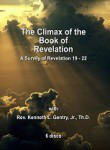 The Climax of the Book of Revelation (Rev 19-22)
The Climax of the Book of Revelation (Rev 19-22)
Six lectures on six DVDs that introduce Revelation as a whole, then focuses on its glorious conclusion. Provides an important, lengthy Introduction to Revelation also.
See more study materials at: www.KennethGentry.com
The second “in the Spirit” section
The second “in the Spirit” experience escorts John into heaven (4:1-2a), where he sees God’s judgment throne and his heavenly judicial courtroom (4:2b-4). There we see the lightning and thunder (4:5) which signify the terrifying theophany from which the judgments flow out against God’s enemies (4:1-16:21). While there in the Spirit John witnesses a session of the divine council (4:1-5:14), which results in a seven-sealed judgment scroll being given to Christ (5:1-4), who will open the seals and unleash the judgments (5:9; 6:1ff).
The third and fourth “in the Spirit” sections
The third (17:1-21:8) and fourth sections (21:9-22:5) have strong introductory parallels, establishing a clear relationship between them and a climax to the whole judicial procedure. Note the parallels:
17:1: “Then one of the seven angels who had the seven bowls came and spoke with me, saying, ‘Come here, I will show you the judgment of the great harlot who sits on many waters…. [17::3] And he carried me away in the Spirit into a wilderness; and I saw a woman sitting on a scarlet beast, full of blasphemous names, having seven heads and ten horns.’”
21:9-10: “Then one of the seven angels who had the seven bowls full of the seven last plagues came and spoke with me, saying, ‘Come here, I will show you the bride, the wife of the Lamb. And he carried me away in the Spirit to a great and high mountain, and showed me the holy city, Jerusalem, coming down out of heaven from God.’”
The third section has John “in the Spirit,” while one of the seven-judgment angels transports him into the wilderness. There he will hear the harlot’s sentence and witness her judgment. The harlot is drunk on the blood of the saints (17:6; 18:24) and intoxicates the nations with her passion to destroy (18:3), so that she deserves a double payback (18:6). Her destruction is sure because “the Lord God who judges her is strong” (18:8, 20). Heaven will praise God’s judgments against her (19:1-3). Her judgment ultimately comes from Christ who appears as the divine warrior (19:11-19).
The fourth “in the Spirit” section has one of the seven-judgment angels carrying John to a great high mountain. There he sees the vindication and reward of the saints (21:9-22:5). In their judicial reward they inhabit the strong, well-protected heavenly Jerusalem come down to earth.
The Structuring Outline
Part I. Introduction (1:1-8)
Part II. In the Spirit on Patmos (1:9-3:22)
Part III. In the Spirit in Heaven (4:1-16:21)
Part IV. In the Spirit in the Wilderness (17:1-21:8)
Part V. In the Spirit on the Mountain (21:9-22:5)
Part VI. Conclusion (22:6-21)
This judicial structuring fits nicely with Revelation’s judicial theme and movement.

THE TWO AGES AND OLIVET
I am currently researching a study of the Two-Age structure of redemptive history. My starting point is based on the disciples’ questions to Jesus in Matthew 24:3. Much confusion reigns among those unacquainted over the Two-Age analysis of history that was promoted by Jesus and by Paul. The Two Ages are not the old covenant and the new covenant, but world history since the fall and the consummate order following the Second Coming and the Final Judgment.
If you would like to support me in my research, I invite you to consider giving a tax-deductible contribution to my research and writing ministry: GoodBirth Ministries. Your help is much appreciated!
March 14, 2023
THE 3.5 YEAR JEWISH WAR IN REVELATION
 PMW 2023-021 by Kenneth L. Gentry, Jr.
PMW 2023-021 by Kenneth L. Gentry, Jr.
A reader of this blog site wrote an insightful and important question. This question is important because preterism emphasizes the history of the Jewish War as it relates to the judgment scenes in Revelation. Rather than treat his question as a comment which would not be seen by many, I thought I would make it an article. I hope you find this helpful.
Bryan Kuranaga question
I don’t know if this question is completely relevant to this post, but I figured it’s a good place to ask it. I was wondering if you have heard/read Phil Kayser’s messages on Revelation? He is also a partial preterist postmillennial and in preaching on Revelation 11:1-7, he writes (taken from the sermon, “The Two Witnesses, Part 1” preached on January 29, 2017):
“So how long was the war? If the only thing you read was the Partial Preterist commentaries (and I am in the Partial Preterist camp that believes most of chapters 1-19 has already been fulfilled) you would get the impression that the war was only three and a half years long. But all the early and later histories of the Jewish War with the Romans refer to it as a seven year war. Josephus, Eusebius, Hegesippus, Yosippon, Seutonius, Tacitus, and other ancient historians are consistent. And modern historians like Cornfeld, Mazar, Maier, and Schurer say the same.”
And
“And that is why it is such a mystery to me that the vast majority of Partial Preterists think of the war as ending in AD 70. It’s a huge mistake. They completely miss the references to the second three and a half years – which in some ways were even more devastating – with millions more being killed during that period.”
This is all from his finished sermon series on Revelation, titled “Revelation Project”
I was wondering if you are familiar with his arguments and what your take on it is.
Thank you so much! I appreciate all the past work and continued work you are doing.
Grace and peace,
Bryan
Gentry Reply
Yes, I know Phil Kayser and appreciate his ministry. And I am thankful for his work on various issues.
I also am familiar with the historical fact that you bring up. However, the point of the Jewish War as God’s judgment was the destruction of the temple (see Matt. 24:2–3), which occurred half-way through the war. By God’s providence, Revelation’s figure or 3.5 years or 42 months also fits the judgment-pattern of a broken seven.
[image error]For more information and to order click here.
" data-image-caption="" data-medium-file="https://postmillennialismtoday.files...." data-large-file="https://postmillennialismtoday.files...." class="alignright size-full wp-image-209" src="https://postmillennialismtoday.files...." alt="Navigating the Book of Revelation: Special Studies on Important Issues" >Navigating the Book of Revelation (by Ken Gentry)
Technical studies on key issues in Revelation, including the seven-sealed scroll, the cast out temple, Jewish persecution of Christianity, the Babylonian Harlot, and more.
See more study materials at: www.KennethGentry.com
The Jewish War was effectively over when the capital city and temple fell. The remaining military engagement was a mopping up operation. This is noted by many historical scholars.
For instance, Jason Thomas Parry (JETS 2011: 524) writes that Vespasian made war “roughly April 67 at Ptolemais [J.W. 3.29] until the fall of Jerusalem in September 70 (J.W. 6.407; 435), a period of three and a half years.”
Neil Faulkner (Apocalypse: The Great Jewish Revolt Against Rome AD 66-73, p. 359) observes that “the Jewish Revolution against Rome ended, to all intents and purposes, when, on 7 September, the morale of the militiamen, who had struggled so hard for so long, suddenly collapsed” (cp. John Court, Myth and History in the Book of Revelation, p. 87 who cites Stanislas Giet).
As Roland Worth expresses it: though Masada remains unconquered until 73, “the conquerors officially treated the war as over, and Vespasian and Titus returned to Rome and celebrated a magnificent Triumph.” This is because “from the practical standpoint, after the fall of Jerusalem all else were mopping-up operations” (Worth, The Seven Cities of the Apocalypse and Roman Culture, 1999, 176).
Considering the above scenario, Moses Stuart (The Apocalypse, 2:279) correctly observes that “the active invasion of Judea continued almost exactly this length of time, being at the most only a few days more; so few that they need not and would not, enter into a symbolical computation of time.”
The Beast of Revelation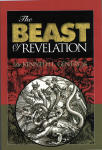
by Ken Gentry
A popularly written antidote to dispensational sensationalism and newspaper exegesis. Convincing biblical and historical evidence showing that the Beast was the Roman Emperor Nero Caesar, the first civil persecutor of the Church. The second half of the book shows Revelation’s date of writing, proving its composition as prior to the Fall of Jerusalem in A.D. 70. A thought-provoking treatment of a fascinating and confusing topic.
For more study materials, go to: KennethGentry.com
Margaret Barker (The Revelation of Jesus Christ, p. 186) agrees that this figure represents “the duration of the final struggle with Rome [for] Vespasian entered Galilee with his armies in the Spring of 67 CE (War 3:29-34) and Jerusalem fell forty-two months later, in September 70 CE.”
This view is also held by J. S. Russell; David Chilton; David Clark; Stanislas Giet; Alan F. Beagley; Alan McNicol; Mireille Hadas-Lebel; G.K. Beale; and Randall C. Gleason (documentation to appear in my commentary on Revelation — if that ever gets released!).
So, from Spring of AD 67 to August/September of AD 70, the time of formal imperial engagement against Jerusalem, is a period right at forty-two months. John Court (87) speaks of “the period of the Flavian war, from the spring of AD 67 to 29 August 70, during which time Jerusalem was ‘profaned.’” Even in Rabbinic tradition we read: “for three and a half years Vespasian surrounded Jerusalem” (Lam. R. 1:31). Of course, all of this fits perfectly within Rev’s temporal limits (1:1, 3; 22:6, 10).
Consequently, I believe the association of forty-two months in Revelation with the Jewish War in history is valid — and helpful.
Thanks again. Keep studying!
THE TWO AGES AND OLIVET
I am currently researching a study of the Two-Age structure of redemptive history. My starting point is based on the disciples’ questions to Jesus in Matthew 24:3. Much confusion reigns among those unacquainted over the Two-Age analysis of history that was promoted by Jesus and by Paul. The Two Ages are not the old covenant and the new covenant, but world history since the fall and the consummate order following the Second Coming and the Final Judgment.
If you would like to support me in my research, I invite you to consider giving a tax-deductible contribution to my research and writing ministry: GoodBirth Ministries. Your help is much appreciated!
March 10, 2023
ON LEAVING HYPERPRETERISM
PMW 2023-020 by Greg Kinser
Gentry note: Below you will find a testimony of one who, by God’s grace, was able to extricate himself from Hyperpreterism. If you know of someone has been reclaimed to Christian orthdoxy after sliding into Hyperpreterism, please send me their testimony. The
MY JOURNEY OUT IN AND OUT OF DARKNESS
By Greg Kinser
THE LATE GREAT PLANET EARTH DELUSION
The word “darkness” in the above title is my reference to a form of eschatology called full- or hyper-preterism. This form of eschatology teaches that all Biblical prophecy has been fulfilled in the events surrounding the destruction of Jerusalem in AD 70. This includes the entire book of Revelation, the Second Coming of Christ, the Resurrection of the Dead, the Day of Judgement, the Millennium, and even the New Heaven and New Earth. How does one come to believe such radical nonsense? I’ll tell you how it happened to me.
I was raised in a very common American Protestant home. My parents were hard-working and honest. I cannot remember a day in my life that I didn’t know Jesus Christ. I had accepted Him as my Savior at a very young age. I never strayed from belief in Him even as a teenager.
My default form of eschatology (study of the last days) was called premillennial dispensationalism, although I had no idea at the time that was its official name. This is probably the most popular form of eschatology in America. It teaches that we are probably the last generation before Jesus Christ returns to secretly rapture away Christians, and before the rise of the Antichrist, the onset of the 7-year Great Tribulation, the Battle of Armageddon, and the Second Coming, etc.
I particularly became interested in this in high school when I read a book by Hal Lindsey called, The Late Great Planet Earth. The details were further flushed out by the writings of men such as J.N. Darby, C.I. Scofield, Clarence Larkin, and more Hal Lindsey books. I particularly loved my Scofield Bible with all its footnotes in this regard. But as I grew up, graduated college, got married, started a family, and was working a job, and even led Bible study groups on the subject, I began to become disenchanted with it. There were so many failed predictions made by its proponents. And even though it was (and still is) very popular, its finer points are very complex and difficult to grasp.
Have We Missed the Second Coming: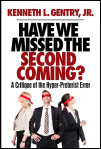
A Critique of the Hyper-preterist Error
by Ken Gentry
This book offers a brief introduction, summary, and critique of Hyper-preterism. Don’t let your church and Christian friends be blindfolded to this new error. To be forewarned is to be forearmed.
For more Christian educational materials: www.KennethGentry.com
POSTMILLENNIALISM SLIDE
About this time, I ran into an elderly man at church who happened to no longer believe this way. He called himself a “postmillennial partial preterist.” He believed, unlike me, that Jesus would return after the Millennium (the thousand years of Revelation 20; thus the prefix “post-“). He was a “partial” preterist because he believed Jesus came back in some form in AD 70 to judge Jerusalem but would return in bodily form in the future.
This man introduced me to the “time statements” of Scripture. The “this generation” of Matthew 24:34, the “some of you will not taste death until…” of Matthew 16:27-28, and the “shortly come to pass… the time is at hand” of Revelation 1:1-3 are all startling when you read them together. He pointed out that time statements like these force us to believe that Jesus came back in some form in the first century AD, the time in which the New Testament was being written.
The Internet was just becoming a thing at that time and, being intrigued by this man’s belief, I did some searching and accidentally ran across a full preterist website managed by Edward Stevens. I had no idea he was a “full” preterist but I was interested in buying a book of his called, What Happened in 70 AD? So, I phoned him and ordered the book. I was not ready for his understanding of Luke 21:20-22 which says, “But when you see Jerusalem surrounded by armies… these are the days of vengeance, that all things which are written may be fulfilled.” Stevens emphasized that “all things which are written” meant the entirety of the Bible’s prophecies. I thought he was crazy. How could the Second Coming of Christ, the Resurrection, the Day of Judgment, and the coming of the New Heaven and Earth have already taken place?! Stevens maintained this had all occurred at the destruction of Jerusalem in AD 70! I took this to my postmillennial friend at church. He, too, thought Stevens was crazy. But a close friend of mine came to believe Stevens was correct and started arguing Stevens’ points with me.
My first rejection of full preterism was that all my study Bibles showed the book of Revelation to have been written in AD 96, so how could it be a prophecy about the events surrounding AD 70? I even asked Stevens, and he pointed me to a book written by Dr. Kenneth Gentry called, Before Jerusalem Fell. This book argues that Revelation was written before AD 70. At this point, I became seriously intrigued.
FULL PRETERISM TRAP
It didn’t take long until every Scripture and every parable Jesus told looked like a reference to AD 70. I joined forums (there was no Facebook at that time) and discovered even more books. Another one that greatly affected me was written in 1878 by James Stuart Russel, called The Parousia. More contemporary authors on this subject were Max King, Don K. Preston, Samuel Frost, Tim King, John Noe, and David Green. I discovered a full-preterist pastor, David Curtis, and was greatly interested in a few active bloggers, Jason Bradfield and Todd Dennis. I even helped Todd Dennis digitize The Parousia for his website (The Preterist Archive). Even books by partial preterists like Gary DeMar helped bolster my newfound belief. I attended a full-preterist conference two years in a row in Sparta, NC, where I met Preston, Frost, DeMar, and Noe.
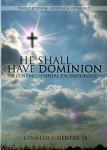
He Shall Have Dominion
(paperback by Kenneth Gentry)
A classic, thorough explanation and defense of postmillennialism (600+ pages). Complete with several chapters answering specific objections.
See more study materials at: www.KennethGentry.com
I, too, like every other full preterist, became enamored with the “time statements.” If you pointed out to me how crazy it was to believe that all Bible prophecy was fulfilled, I would just simply make you read the “time statements.” It is the “time statements” of Scripture that lead every single full preterist into full preterism and it is what keeps them there. I cannot emphasize this enough. I began to interpret (reinterpret) every single doctrine of Christianity through this filter. Every Scripture in the Bible was made to bow its knee to the “time statements.” But eventually, this is what started to bug me because it made me question all the fundamentals. For instance, was I to keep the sacrament of the Lord’s Supper? After all, Paul wrote, “for as often as you eat this bread and drink this cup, you proclaim the Lord’s death till He comes” (1Corinthians 11:26). And if Jesus had already come in AD 70, then was there any need to “proclaim the Lord’s death” through this sacrament?
I couldn’t find any theologians that were full preterists. I found out that Sam Frost was an up-and-coming theologian who was attempting to systematize full preterism. Being intrigued by this, I bought his book, Misplaced Hope. Frost wrote on page 210, “Modern Christian eschatology is based upon an early church error: assuming the Second Coming was delayed, by misunderstanding its spiritual fulfillment in A.D. 70. We need not remain in this wilderness of misplaced hope. Rather, through sound biblical scholarship, we can recover the transforming hope that the early church embraced. Herein lies our hope for the third Christian millennium.” This book bugged me even more. It was arguing how the earliest Christians missed the Second Coming in AD 70 and since it didn’t happen, opted to reinterpret the “time statements” to mean imminence for every generation instead of imminence for that first generation of Christians. This forced me to think that in order to maintain my position in full preterism, I was going to have to say all (not some!) the early Christians missed it. I would have to somehow maintain that millions of Christians for 2000 years had all missed Christ’s Second Coming in AD 70 and that the Church for two millennia had “accidentally” propagated a serious lie! Now I was a bit more than just bugged. I was now growing a bit fearful of what I was believing and teaching.
RESURRECTION PAINS
The one thing that kept coming up in my heart was, “How could all Christians have missed the resurrection of the dead until full preterists came along?” This question started my long and very uncomfortable study of resurrection as a full preterist. Most full preterists are too starry-eyed with the “time statements” to even care about the resurrection of the dead. They simply point out that if the “time statements” were true, and they must be, then whatever the resurrection was, it was in the past. Staring me in my full-preterist face were the Apostle Paul’s obvious feelings about getting the timing of the Resurrection wrong. He wrote:
But shun profane and idle babblings, for they will increase to more ungodliness. And their message will spread like cancer. Hymenaeus and Philetus are of this sort, who have strayed concerning the truth, saying that the resurrection is already past; and they overthrow the faith of some. (2Timothy 2:16-18)
This is a sober warning. Full preterists, of course, will answer this passage and say that the Resurrection was future to them when Paul wrote this to Timothy because it was before AD 70. But we live after the Resurrection in AD 70 making this no problem to them. But the point I’m making here is that getting the timing of the Resurrection wrong was a very serious thing in Paul’s mind. This put the fear of God in me. At this point, I stopped teaching full preterism and sought the Lord for the truth and meaning of resurrection.
I began by asking every full preterist I knew exactly what they thought the resurrection was. As it turns out they are wildly divided on the subject. There are two major camps in full preterism. They call themselves CBV or IBV.
Your Hope in God’s World (postmillennial DVD lectures by Gentry).
Presents the theological and exegetical argument for the postmillennial hope in our fallen world.  The last lecture answers the major practical, theological, and exegetical objections to postmillennialism.
The last lecture answers the major practical, theological, and exegetical objections to postmillennialism.
For more educational materials: www. KennethGentry.com
RESURRECTION DIVISIONS IN FULL PRETERISM
CBV stands for Collective (or Covenant, or Corporate) Body View. IBV stands for Individual Body View. The originator of CBV is Max King (1930-). It is mainly propagated by Don K. Preston (1949-). The IBV leader seems to be Edward Stevens.
The main difference between CBV and IBV is stated easily enough but the details are complex and vary widely depending on who’s interpreting the viewpoint. Both beliefs teach a “resurrection” of sorts occurring in AD 70 when they allege Jesus’ Second Coming occurred. CBV teaches a resurrection of a collective kind of body of believers, while IBV teaches that Christians were raised out of Sheol/Hades to put on their new individual spiritual bodies. Studying the chart below will help you with the details.
I will remind you that the details of the views of CBV and IBV can vary slightly depending on the teacher. But these are close.
Make note that both CBV and IBV teach that your physical body is discarded and is never resurrected like Christ’s. Both CBV and IBV have no care for your physical body. It is merely a temporary holding place for your spirit which, they assert, is all that salvation is really about. They also both teach that Christ’s physical resurrection was merely a sign for that generation and, otherwise, it has no direct relationship to us today!
Don K. Preston teaches some very bizarre and blasphemous details in his version of CBV. The first weird thing is he teaches Adam was created mortal and that physical death was always part of God’s creation, and God never had a plan to deal with that! He also teaches that since salvation is thought to be spiritual-only, then he asserts Adam died spiritually necessitating that Christ die spiritually as well. Most Christians would never say that Jesus died spiritually because it causes a fatal theological problem for the doctrine of the Trinity. To die spiritually, God the Son would have to be separated from God the Father! Preston also teaches that when Jesus was resurrected, He was raised in a mortal body (not an immortal one); the same one He had before the cross! He further maintains that this mortal body ascended to Heaven and was completely incinerated as a whole burnt offering on the altar of the Heavenly Temple and therefore Jesus no longer resides in a physical body, immortal or mortal! This is considered blasphemy of the highest sort in normal Christianity.
 Why I Left Full-Preterism (by Samuel M. Frost)
Why I Left Full-Preterism (by Samuel M. Frost)
Former leader in Full Preterist movement, Samuel M. Frost, gives his testimony and theological reasoning as to why he left the heretical movement. Good warning to others tempted to leave orthodox Christianity.
See more study materials at: KennethGentry.com
Edward Stevens’ IBV forces him to teach some very bizarre things as well. By his own admission, because of the “time statements,” he must maintain that a rapture of the living Christians occurred in AD 70. That means living Christians were translated bodily without dying leaving no Christians on Earth after AD 70! Of course, there’s no historical record, Christian or secular, that tells of any sudden disappearance of thousands if not millions of Christians in AD 70. This further begs the question that if there were no Christians left on Earth after AD 70, how did the gospel get restarted and reach us here 2000 years later?! This view would also have to maintain that Christians who lived through AD 70 (i.e. Clement) missed the rapture or are liars. Did God leave some Christians on Earth after AD 70 so Christianity could get a restart?!
Needless to say, these are not satisfying answers. CBV is blasphemous of Christ’s eternal incarnation, and IBV denies actual history in favor of “time statements”! With no hope of finding any answers from the full preterist camp, I devoted myself to studying resurrection. It was now me and my Bible. This sounds noble. But it is less noble than you might think. I’ll explain in a few minutes.
RESURRECTION TRUTH #1 – THE UNJUST
The first Scriptural passage that dealt a fierce blow to my full preterism is that written by the Apostle John. According to Jesus Himself, the resurrection would include all human beings, righteous and unrighteous, just and unjust. He said, “Do not marvel at this; for the hour is coming in which all who are in the graves will hear His voice and come forth—those who have done good, to the resurrection of life, and those who have done evil, to the resurrection of condemnation.” (John 5:28-29). The Apostle Paul affirmed as well, saying, “I have hope in God, which they themselves also accept, that there will be a resurrection of the dead, both of the just and the unjust.” (Acts 24:15). Did you notice that in the explanation of what CBVs and IBVs believe they did not deal with the “resurrection of condemnation” nor the “resurrection of …the unjust”?
When faced with Acts 24:15 above, most full preterists will just change the subject to their beloved “time statements.” They will point out that the Greek word translated, “shall be” in this verse, is the Greek word, μελλειν (mellein) which, they say, means, “about to.” They will then find every occurrence of this Greek word in the New Testament and substitute their limited definition of “about to” in its place. This allows them to produce even more “time statements” in order to emphasize this resurrection, whatever it is, happened in the first century AD. But you can reference any Greek lexicon and see that the Greek scholars say this word actually means, “a certainty of action,” and the context can cause it to be translated as “about to” only because of certainty.
RESURRECTION TRUTH #2 – OUR RESURRECTION IS THE SAME AS CHRIST’S
The second Scriptural blow to my full preterism was the way in which the Apostle Paul argued the resurrection in 1Corinthians 15. It was almost the opposite direction of logic than one would think he would make. Instead of saying our resurrection was based on Christ’s resurrection (which theologically, of course, it is!), Paul argued it in the other direction, writing:
But if there is no resurrection of the dead, then Christ is not risen. And if Christ is not risen, then our preaching is empty and your faith is also empty. Yes, and we are found false witnesses of God, because we have testified of God that He raised up Christ, whom He did not raise up—if in fact the dead do not rise. For if the dead do not rise, then Christ is not risen. And if Christ is not risen, your faith is futile; you are still in your sins! (1Corinthians 15:13-17)
Notice Paul says if there is no resurrection of the dead, then Christ is not resurrected. He does not say that if Christ is not resurrected, there is no resurrection of the dead. In other words, he’s basing Christ’s resurrection on the fact of our resurrection. You might think this is a moot point, but it is not. The reason is that arguing it this way makes certain of the definition of what resurrection means. Both resurrections (ours and Christ’s) must be of the same type. Whatever definition you give the resurrection of the dead, you must also apply to Christ. And if you maintain Christ’s resurrection was a physical transformation of His mortal human body, then our resurrection must also be a transformation of our mortal human body. This is devastating to full preterism.
This critical and logical link is further corroborated by the fact that Jesus Christ is called “the firstfruits of those who have fallen asleep” (1Corinthians 15:20,23) and “the firstborn from the dead” (Colossians 1:18). The Firstfruits (Christ’s resurrection) cannot be different from the harvest (our resurrection). The Firstborn from the dead (Jesus) implies a second-born, a third-born, etc., i.e. us! You don’t gather apples as the firstfruits, and then when harvest comes, discover that you are now gathering oranges. So, staring me in the face at this point was the empty tomb; the 2000-year-old orthodox view of the resurrection of the dead. This was the heaviest blow against my full preterism and the third Scriptural consideration would nudge it nearly off the edge of the cliff toward oblivion.
RESURRECTION TRUTH #3 – BODIES ARE TRANSFORMED NOT DISCARDED
In the Apostle Paul’s letter to the Philippians, he writes:
For our citizenship is in heaven, from which we also eagerly wait for the Savior, the Lord Jesus Christ, who will transform our lowly body that it may be conformed to His glorious body, according to the working by which He is able even to subdue all things to Himself. (Philippians 3:20-21)
Notice that Paul says “our lowly body” would be “transformed” to become like “His glorious body.” The believer’s body was to be “transformed,” not discarded to rot in the grave while the believer is given a different body. This destroys IBV full preterism. This is exactly what happened to Christ’s mortal body. The tomb was empty. His mortal body was not discarded to obtain His immortal spiritual body. His mortal body was transformed. It still had the scars to remind us of His sacrifice.
THE TWO AGES AND OLIVET
I am currently researching a study of the Two-Age structure of redemptive history. My starting point is based on the disciples’ questions to Jesus in Matthew 24:3. Much confusion reigns among those unacquainted over the Two-Age analysis of history that was promoted by Jesus and by Paul. The Two Ages are not the old covenant and the new covenant, but world history since the fall and the consummate order following the Second Coming and the Final Judgment.
If you would like to support me in my research, I invite you to consider giving a tax-deductible contribution to my research and writing ministry: GoodBirth Ministries. Your help is much appreciated!
Not only this, but you must consider also that when Paul wrote this, both of the bodies he spoke of (“our lowly body” and Christ’s “glorious body”) existed simultaneously. What is the significance of this? It destroys CBV full preterism. There wasn’t just a single body being changed into a future single body like the CBV folks imagine. Instead, there were already two bodies when Paul wrote. There was the (1) “lowly body” of a believer and (2) the “glorious body” of Christ. But at some point in the future, Paul imagines there would still be two bodies, only they would be (1) the “lowly body” that had been “transformed” and (2) the “glorious body” of Christ.
JESUS CHRIST IS STILL INCARNATE
Furthermore, in corroboration that Jesus was still a physical Man after His ascension and will remain so even unto the Day of Judgment, Paul says, “Truly, these times of ignorance God overlooked, but now commands all men everywhere to repent, because He has appointed a day on which He will judge the world in righteousness by the Man whom He has ordained. He has given assurance of this to all by raising Him from the dead” (Acts 17:30-31). Also, Paul writes, “For there is one God and one Mediator between God and men, the Man Christ Jesus” (1Timothy 2:5). Furthermore, Jesus, after His ascension, is referred to be “the image of God” (2Corinthians 4:4) and “the image of the invisible God” (Colossians 1:15), and also it is said that “in Him dwells all the fullness of the Godhead bodily” (Colossians 2:9). Images are visible. God is not visible, but God the Son, Jesus Christ is. How could He not be? Afterall, He is our Mediator between God (invisible) and man (visible). This is what makes Him our faithful High Priest as the writer of Hebrews says: “Therefore, in all things He had to be made like His brethren, that He might be a merciful and faithful High Priest in things pertaining to God, to make propitiation for the sins of the people” (Hebrews 2:17). …
To read the rest of the article and see the charts, go to:
http://qgregsbiblestudy.blogspot.com/2023/01/my-journey-in-and-out-of-darkness.html
Greg Kinser is a Technical Service Engineer who lives in Bluff City, Tennessee (where Ken Gentry went to his first two years of high school!).
March 7, 2023
ACTS 1:9-11 AND HYPER-PRETERISM
PMW 2023-019 by Keith A. Mathison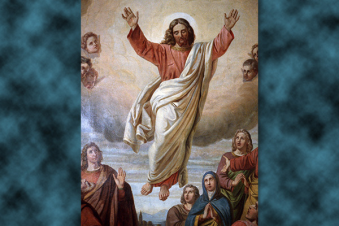
This is an abbreviated summary of Matthison’s full article, which may be found in full (with footnotes) at:
https://hyperpreterism.com/acts-19-11-and-the-hyper-preterism-debate/
INTRODUCTION
In recent years a challenge to traditional orthodox eschatology has arisen in the form of a doctrine that may be termed “hyper-preterism.” According to proponents of this doctrine, the Christian church has been mistaken in its expectation of a future Second Advent. According to proponents of this doctrine, all New Testament prophecy was fulfilled in the first century. This means that, according to hyper-preterism, the Second Advent, the general resurrection, and the final judgment, among other things, are past events. The emergence of this doctrine has generated a vigorous ongoing debate that shows no sign of slowing.1
Much of the exegetical attention in the ongoing debate over hyper-preterism has centered on biblical texts such as Matthew 24–25 (The Olivet Discourse) and the Book of Revelation. However, much less attention has been given to the text of Acts 1:9–11.2
This is somewhat surprising because traditionally Acts 1:11 has been understood to be a clear and unambiguous promise of the personal, visible, and bodily Second Coming of Jesus Christ to earth. The text is significant to the current debate because in order to assert that the Second Advent occurred in the first century, most hyper-preterists have insisted that the event was either invisible (occurring in the spiritual realm) or visible only to those Christians with the spiritual perception to see.3 Acts 1:9–11, however, seems to describe something more — namely, a bodily ascension from earth and the promise of a corresponding bodily return to earth. Of course, if Acts 1:9–11 promises an objectively visible bodily return of Jesus to this earth, this would create serious problems for the hyper-preterist thesis, since there does not appear to be any evidence that anything of the sort occurred in the first century.4 It is for this reason that a much more thorough examination of this text of Scripture is required in light of the current debate….
The writing of Acts that range from A.D. 62 until well into the middle of the second century. The strongest arguments appear to support a date somewhere between A.D. 62 and A.D. 64.62.
Luke’s prologue to his Gospel helps us identify his basic purpose in writing both the Gospel itself and the Book of Acts. In this prologue, Luke writes, Inasmuch as many have undertaken to compile a narrative of the things that havebeen accomplished among us, just as those who from the beginning were eyewitnesses and ministers of the word have delivered them to us, it seemed good
to me also, having followed all things closely for some time past, to write an orderly account for you, most excellent Theophilus, that you may have certainty concerning the things you have been taught (Luke 1:1–4, ESV).63
 Why I Left Full-Preterism (by Samuel M. Frost)
Why I Left Full-Preterism (by Samuel M. Frost)
Former leader in Full Preterist movement, Samuel M. Frost, gives his testimony and theological reasoning as to why he left the heretical movement. Good warning to others tempted to leave orthodox Christianity.
See more study materials at: KennethGentry.com
There are a couple of important things to observe in this passage. First, Luke’s purpose is to write an orderly account of the things that happened. He is aware of other written accounts of these things, and he says that he is among those to whom accounts of these
things have been delivered by eyewitnesses. In other words, Luke’s primary purpose in writing was historical. Second, Luke is providing Theophilus with this historical account in order that he may have certainty concerning the things he has been taught (1:4). In other words, Luke is not writing history for history’s sake. He is providing Theophilus with a certain historical foundation for his Christian faith. Luke intended his Gospel and the Book of Acts to accurately present the things that actually happened according to eyewitnesses. Like Peter, Luke refused to “follow cleverly devised myths” (2 Pet. 1:16).The Book of Acts, therefore, is best described as a historical book.64
THE TEXT
We now come to the key question in the debate: “What saith the Scripture?” As we have seen, hyper-preterists have suggested a number of objections to the traditional interpretation of this text and have offered a number of potential alternative interpretations in its place. Each of these objections and alternative interpretations will be discussed as we proceed with a positive exegesis of the text.
THE CONTEXT
The account of the ascension in Acts 1:9–11 occurs at the very beginning of the Book of Acts. It is important, therefore, to understand it in the broader context of the narrative of Luke-Acts. How does this text fit into the broader context? Why is it found at this point in the narrative? What is Luke’s point? At the most basic level, Luke’s point is to write an accurate account of what happened at Jesus’ final appearance to his apostles after the resurrection. The ascension narrative in Acts 1 is presented as a
straightforward historical narrative. There is a repeated emphasis in verses 9–11 on the fact that there were eyewitnesses to the event (cf. 1 John 1:1). The ascension itself is treated in the immediate context as the last event of Jesus’ earthly ministry (Acts 1:22). As Bruce Metzger explains, “The special contribution which Luke makes is to suggest that the ascension was an event as real and objective as the other appearances of the risen Lord.”65
Luke does not provide this account, however, simply to satisfy our historical curiosity. The ascension account also forms an important part of Luke’s overall narrative purpose. In the context of Luke’s broader narrative (Luke-Acts), this historical account
of the ascension serves as a transition point, a “hinge,” as it were, between the Gospels and the church, between Jesus and the Spirit. It is interesting to observe, for example, the frequency of the term pneuma (“spirit”) in the Gospels in comparison to its frequency in Acts. In Matthew, the word pneuma occurs 19 times; in Mark, 23 times; in Luke, 36 times; in John, 24 times. In Acts, however, the word is used 70 times. Jesus explained to his disciples, “it is to your advantage that I go away, for if I do not go away, the Helper will not come to you. But if I go, I will send him to you” (John 16:7). It makes perfect sense, therefore, for Luke to introduce the era of the Spirit with the account of Jesus’ departure. According to Jesus’ own words, his departure (Acts 1) is a necessary condition for Pentecost (Acts 2).
Luke’s account of the ascension also provides a turning point in the apostles’ understanding of the kingdom of God. In Acts 1:3, Luke tells us that after the resurrection, Jesus appeared to the apostles over a period of forty days, speaking to them about the kingdom of God. At his last appearance, immediately before the ascension, the apostles ask Jesus a question about the kingdom of God: “Lord, will you at this time restore the kingdom to Israel?” (Acts 1:6). After Jesus ascension, whatever confusion may have remained in the apostles’ minds regarding the kingdom had been completely dispelled. From the ascension onward, they are found confidently proclaiming the kingdom of God (Acts 8:12; 14:22; 19:8; 20:25; 28:23, 31). They are found proclaiming that Christ is now king (Acts 17:7; cf. 2:36). The same proclamation is found in the books these apostles wrote after the ascension (cf. Col. 1:13; Heb. 12:28; Rev. 1:6, 9). The book of Acts begins (1:3) and ends (28:31) on the subject of the kingdom, and the ascension of Christ, as we will see, is what cemented the apostles’ understanding of this key doctrine.
Why Not Full-Preterism? by Steve Gregg
This work exposes some of the key flaws in Hyperpreterism by someone who has formally debated them. Much insightful material for those who might be tempted to forsake historic Christian orthodoxy.
For more Christian educational materials: www.KennethGentry.com
ACTS 1:1–8
In Acts 1:1–8, Luke introduces the events that lead up to the account of the ascension itself in verses 9–11. Verses 1–5 form a prologue that ties the Book of Acts to the Gospel of Luke and introduces the events to follow.
“In the first book, O Theophilus, I have dealt with all that Jesus began to do and teach, until the day when he was taken up, after he had given commands through the Holy Spirit to the apostles whom he had chosen. To them he presented himself alive after his suffering by many proofs, appearing to them during forty days and speaking about the kingdom of God. And while staying with them he ordered them not to depart from Jerusalem, but to wait for the promise of the Father, which, he said, “you heard from me; for John baptized with water, but you will be baptized with the Holy Spirit not many days from now” (1:1–5).
Luke here describes his Gospel as “the first book,” with the implication that Acts is a “second” book. He informs his readers that Jesus appeared to the apostles over a period of forty days after his death and resurrection. He offered many proofs that he was truly
alive (cf. Luke 24:39–43), and he spoke to them about the kingdom. Jesus also commanded the apostles to wait in Jerusalem for the promise of the Father — the baptism of the Holy Spirit (1:4–5; cf. Luke 24:49).
Following this brief prologue, Acts 1:6–8 provides the immediate context for the ascension account:
“So when they had come together. They asked him, ‘Lord, will you at this time restore the kingdom to Israel?’ He said to them, ‘It is not for you to know times or seasons that the Father has fixed by his own authority. But you will receive power when the Holy Spirit has come upon you, and you will be my witnesses in Jerusalem and in all Judea and Samaria, and to the end of the earth.’:
The apostles have gathered together with Jesus on the Mount of Olives (cf. Acts 1:12) just east of Jerusalem. The apostles ask him a question about the kingdom, specifically whether he would “at this time” restore it to Israel. Jesus does not answer either yes or
no. Instead, he tells the apostles that it is not for them to know “times or seasons.”66 Jesus then reminds the apostles of the promise of the Father they are to await in Jerusalem (cf. 1:5). He tells them they will receive power when the Holy Spirit comes
upon them. He then gives the apostles their last commission, telling them they will be his witnesses in Jerusalem, Judea, Samaria, and to the end of the earth.
The apostles’ question indicates that they continued to conceive of the kingdom in too limited and exclusive a sense.67 They continued to think only in terms of the nation of Israel. Jesus’ answer to their question pointed to a much different concept of the
kingdom. The apostles were to be his witnesses not only in Jerusalem and Judea, but also in Samaria and to the very ends of the earth. Israel had been commissioned with this task under the Old Covenant (cf. Isa. 43:10; 44:8; 49:6), but she failed. The task was now given to the new Israel.68 Many commentators believe this commission acts as a kind of key to the structure of Acts with the apostles preaching in Jerusalem in Acts 1–7, in all Judea and Samaria in 8:1–11:18, and to the ends of the earth in 11:19–28.69
Have We Missed the Second Coming:
A Critique of the Hyper-preterist Error
by Ken Gentry
This book offers a brief introduction, summary, and critique of Hyper-preterism. Don’t let your church and Christian friends be blindfolded to this new error. To be forewarned is to be forearmed.
For more Christian educational materials: www.KennethGentry.com
ACTS 1:9
“And when he had said these things, as they were looking on, he was lifted up, and a cloud took him out of their sight.”
The entire account of the ascension is told very succinctly in three verses. Luke connects Acts 1:9 to the previous text with the conjunction kai (“and”) and two participles: the aorist participle eipōn (“after he said,” or “when he had said”) and the present participle blepontōn (“while they were looking,” or “as they were looking”). As C.K. Barrett observes,
“The contrast between aorist and present participles is intentional and significant.Jesus has now said all that he has to say to his disciples. The promise of the Spirit and the commission to act as witnesses complete his work on earth. The disciples
however are still looking at him, and are thus able to vouch for his ascent into heaven.”70
As we noted above, Randall Otto argues that Luke’s use of a form of the verb blepō does not require us to assert that the disciples were actually looking at Jesus. He argues that had Luke intended this meaning, he certainly would have mentioned Christ as the direct object. He then adds, “according to the standard Greek lexicon, blepō is used here abstractly; there is no object at which the disciples can be said to be looking.”
There are several problems with Otto’s line of reasoning. First, he is ignoring the immediate context. According to the context, the entire ascension event, including the lifting up of Jesus, is what the disciples saw in verse 9. And if it is still claimed that the disciples were not looking at Jesus himself, all we have to do is observe the content of verse 11, which does provide an explicit direct object, saying: “you saw him (auton) go.”71 Second, Otto’s claim about the definition of blepō in the standard Greek lexicon is incorrect. The second edition of the Bauer, Arndt, Gingrich Greek-English lexicon (the lexicon cited by Otto) does not say that blepō is used “abstractly” in Acts 1:9. The meaning of the abbreviation “abs.” is provided in the introductory pages of the lexicon. According to the editors, it means “absolute,” not “abstract.”72
For those, such as Otto, who want to restrict the meaning of blepō to “spiritual perception,” the text of Acts 1:9–11 provides no support. While it can be used in that sense, “blepō in general simply refers to the capacity to see, of sense perception.”73 Of
course, the meaning of any word is determined by its context, so the ques ion is whether the meaning of blepō in the context of Acts 1:9 refers to perception with the eye or to some kind of spiritual perception. Significantly, the context presents the ascension as an observable historical event in the same category as the other events in the life of Jesus.74 It is not presented as a “visionary” experience. Furthermore, Luke uses other terms in addition to blepō to describe the visibility of this event. In addition to using a form of the word blepō twice in these three verses, Luke also uses the words atenizō (1:10) and theaomai (1:11). I will discuss the way these words are used in the New Testament below, but suffice it for now to say that they provide no support for the idea that the apostles saw the ascension only with the “eye of faith.”
Luke next tells us that after Jesus had said these things (1:6–8), and while they were looking on, “he was lifted up.” The verb is the aorist, passive, indicative of epairō (“to lift up”). As we observed above, Randall Otto argues that in the passive voice, epairō “does not have to do with an active physical lifting up but with a lifting up of someone in stature or dignity.” It has to do with “exaltation.” Otto again cites the BAGD lexicon as support for this interpretation, and again there are a number of problems with his use of the evidence. First, the BAGD lexicon does not indicate epairō means “exaltation” when used in the passive voice. It lists under the passive use of the verb two subcategories: a literal meaning (“be taken up”) and two figurative meanings (“offer resistance” and “be presumptuous”). It lists the use of epairō in Acts 1:9 under the literal meaning.75 The newly revised third edition of Bauer’s lexicon is even clearer in that it simply places the use of epairō in Acts 1:9 under the definition “to cause to
move upward, lift up, hold up).76
Otto also makes much of the fact that the BAGD lexicon lists 1 Clement 45:8 as another text that includes the verb epairō in the passive voice. He says, “As we can plainly here see, the only other similar use of this word does not denote a literal and
physical elevation of the person, but rather describes in figurative terms the elevation of the person in honor and dignity, i.e., exaltation.”77 Several observations are in order. In the first place, it must be noted that the editors of the lexicon do not place 1 Clement 45:8 under either of the two figurative meanings of the verb. It is listed, along with Acts 1:9, under the literal meaning of the verb (i.e. to “be taken up”). Secondly, the editors define the meaning of the verb in 1 Clement 45:8 as “the exaltation to heaven of those who endured.”78 The passage in 1 Clement is discussing those who suffered persecution and martyrdom but persevered in faith until the end. They may have died, but they were “exalted to heaven” or “lifted up to heaven.”79 Of course, in 1 Clement this is not referring to the physical lifting up of their bodies to heaven. It is referring to the lifting up of their souls or spirits to heaven. But this is not something that is found in the meaning of the verb itself. It is something that must be determined by the context.
Finally, it is incorrect to claim that 1 Clement 45:8 contains the only other similar use of this verb. It may be the only other use of this verb in the passive voice that has been found thus far in the literature of this time, but this is not as significant as Otto assumes.
The most important clue to the meaning of the word epairō in Acts 1:9 is its use elsewhere in the New Testament. In these books, the verb is used approximately 20 times. An examination of each of the texts in which it is found reveals that epairō is not used to refer to the lifting up of someone in stature, dignity, or honor. In other words, it is not used to mean “exaltation” in the New Testament literature.80 In the majority of cases, it is used in connection with the “lifting up” of one’s eyes (e.g., Matt. 17:8), or
one’s voice (e.g., Acts 2:14). It is also used to refer to the lifting up of one’s hands (Luke 24:50; 1 Tim. 2:8), one’s head (Luke 21:28), or the sail of a ship (Acts 27:40). It is used once in the figurative sense of “rising up in opposition” (2 Cor. 10:5) and once in the sense of “being presumptuous” (2 Cor. 11:20). The only meaning of epairō that makes sense in the context of Acts 1:9–11 is the literal meaning “to cause to move upward.” The passive voice does not change the meaning of this verb. It simply indicates that Jesus was not the agent who lifted himself up. He was “lifted up” by someone or something else.
Understanding the Olivet Discourse 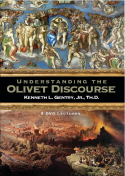
By Ken Gentry
This 5 DVD lecture set was filmed at a Bible Conference in Florida. It explains the entire Olivet Discourse in Matt. 24–25 from the (orthodox) preterist perspective. This lecture series begins by carefully analyzing Matt. 24:3, which establishes the two-part structure of the Discourse. It shows that the first section of the Discourse (Matt. 24:4–35) deals with the coming destruction of the temple and Jerusalem in AD 70. This important prophetic event is also theologically linked to the Final Judgment at the end of history, toward which AD 70 is a distant pointer.
For more educational materials: www. KennethGentry.com
Furthermore, even if it were true that the verb epairō had the idea of exaltation in honor as one of its possible meanings in the first century, it is not the only verb used to describe the actual ascension of Jesus in this passage. Luke also uses the terms
hupolambanō, poreuomai (twice), and analambanō. Both hupolambanō, and analambanō are typically used to mean “to take up” and poreuomai is typically used to mean “to go” or “to proceed.” The standard lexicons do not list “exaltation” as a normal
meaning of any of these terms. In other words, what Luke is describing in this passage is a visible upward motion of a person. This does not mean that exaltation was not involved in the ascension of Jesus. Luke indicates elsewhere that Christ’s exaltation involved both his resurrection and ascension (cf. Acts 2:30–34), but the fact that Jesus was exalted in his resurrection and ascension does not mean that there was no literal bodily ascension any more than it means there was no literal bodily resurrection. It should also be pointed out that when Luke speaks of exaltation in Acts 2 and elsewhere, he generally uses the verb hupsoō (cf. Acts 2:33; 5:31). He does not use that term in Acts 1:9–11. The primary emphasis in Acts 1:9–11 is on what the apostles saw with their eyes. Luke focuses on the theological explanation of this event elsewhere.
Luke concludes verse 9 with the statement, “and a cloud took him out of their sight.” The first question that must be answered in connection with this phrase is the precise meaning of kai, the Greek word translated “and.” The significant question is whether kai is being used here as a simple connective conjunction or as an explicative conjunction.81 In other words, is the intended meaning: “he was lifted up, and then a cloud took him out of their sight” (connective)? Or is the meaning: “he was lifted up; that is, a cloud took him out of their sight” (explicative)? In terms of what Luke says the apostles witnessed, the question is whether:
1. They saw Jesus ascend a certain distance and then disappear from their sight when he reached the cloud — ascension to a cloud.
2. They saw the cloud appear to actively lift Jesus upward a certain distance before he disappeared from their sight — ascension in or with a cloud.
3. They saw Jesus suddenly vanish into a cloud while he was standing before them without any visible upward motion of either Jesus or the cloud.
Answer 1 would be the implication of the connective use of kai. The explicative use of kai could imply either answer 2 or answer 3. The only way to determine which answer is the most likely meaning intended by Luke is to examine the context….
To finish reading and see the footnotes, go to:
https://hyperpreterism.com/acts-19-11-and-the-hyper-preterism-debate/
THE TWO AGES AND OLIVET
I am currently researching a study of the Two-Age structure of redemptive history. My starting point is based on the disciples’ questions to Jesus in Matthew 24:3. Much confusion reigns among those unacquainted over the Two-Age analysis of history that was promoted by Jesus and by Paul. The Two Ages are not the old covenant and the new covenant, but world history since the fall and the consummate order following the Second Coming and the Final Judgment.
If you would like to support me in my research, I invite you to consider giving a tax-deductible contribution to my research and writing ministry: GoodBirth Ministries. Your help is much appreciated!
March 3, 2023
THE OPTIMISM OF POSTMILLENNIALISM
PMW 2023-018 by Kenneth L. Gentry, Jr.
People often how postmillennialism claims to be optimistic and charges other millennial views to be pessimistic. Many even see very little difference between amillennialism and postmillennialism, which were originally deemed one eschatological position up until the last 1800s.
Of course, representatives of the three standard non-postmillennial schools (amillennialism, premillennialism, and dispensationalism) do not like being called “pessimistic.” And we must admit that all four millennial schools are Christian systems committed to the expectation of ultimate redemptive hope. They unite in believing that God will finally conquer sin and Satan and establish an eternal order of glorious perfection.
(Interestingly, a new theological system known as Full Preterism (aka Consistent Preterism or Covenant Preterism or Hyperpreterism) cannot be characterized by any millennial label. For the historic labels (whether “a,” “pre,” or “post”) all refer to the bodily return of Christ and its relation to the “millennium.” But this new theology does not believe in Christ’s future, bodily second coming. What is more, in most manifestations of this new religious view, the adherents do not even believe that history will ever end. And since they believe all prophecy in Scripture was fulfilled when Roman defeated Israel in the Jewish War of AD 70, they do not believe history will ever end and therefore that it will never be finally judged and removed from the universe. They believe God will endure a rebellious universe forever and ever. Thus, though popular with hundreds of people today and dozens of churches, this view is truly pessimistic in the long run.)
 The Harrowing of Hell (by Jay Rogers)
The Harrowing of Hell (by Jay Rogers)
This postmillennial book examines the power of the Gospel, not only to overcome all opposition, but to rise far above the powers of hell. The term “Harrowing of Hell” refers to idea that Christ descended into Hell, as stated in the Apostles’ Creed.
For more Christian educational materials: www.KennethGentry.com
Nevertheless, the standard millennial views differ in how they understand the redemptive hope’s impact in history and before Christ returns. Despite their agreement on the ultimate victory of God in eternity, three of the systems are historically pessimistic, and only one is optimistic. The three pessimistic systems are premillennialism, amillennialism, and dispensationalism.
The pessimism-optimism issue is the key matter distinguishing postmillennialism from the other three systems. But what do we mean by labeling them “pessimistic”? Those eschatologies are pessimistic in that:
• They deny that Christ’s church will grow to exercise a worldwide gracious influence over all the affairs of man before Christ returns.
• They deny that Christians should plan on and labor toward gospel victory in history.
• They agree that history will ultimately collapse into chaos and despair before Christ returns.
The postmillennial system is historically optimistic in that it takes the opposite position on each of these three issues.
THE TWO AGES AND OLIVET (advertisement)
I am currently researching a study of the Two-Age structure of redemptive history. My starting point is based on the disciples’ questions to Jesus in Matthew 24:3. Much confusion reigns among those unacquainted with the Two-Age analysis of history, which was promoted by Jesus (Matt. 12:32; Mark 10:29-30) and by Paul (Gal. 1:4; Eph. 1:21). The Two Ages are not the old covenant and the new covenant, but world history since the fall and the consummate order following the Second Coming and the Final Judgment.
If you would like to support me in my research, I invite you to consider giving a tax-deductible contribution to my research and writing ministry: GoodBirth Ministries. Your help is much appreciated!
Click on the following images for more information on these studies:



March 2, 2023
CONCERNS RE: GARY DEMAR
 With a heavy heart this private letter to Gary DeMar has been approved for public posting by its signatories: Andrew Sandlin, Ken Gentry, Doug Wilson, Jeffery Ventrella, Phillip Kayser, John Frame, Ardel Caneday, Jeff Durbin, James White, Brian Mattson, Keith Sherlin, Jason Bradfield, Sam Frost, and Uriesou Brito
With a heavy heart this private letter to Gary DeMar has been approved for public posting by its signatories: Andrew Sandlin, Ken Gentry, Doug Wilson, Jeffery Ventrella, Phillip Kayser, John Frame, Ardel Caneday, Jeff Durbin, James White, Brian Mattson, Keith Sherlin, Jason Bradfield, Sam Frost, and Uriesou Brito
Please be in prayer for Gary, that he would return to orthodoxy on these important redemptive-eschatological issues. Here is the letter we sent twice to Gary in private:
Gary DeMar:
We are your brothers in the Lord, long-time friends, supporters, co-laborers in his Word, and co-promoters and defenders of the Christian worldview. We have contacted you privately twice in the last few months regarding our concerns, with the following:
We are writing to you once again with an earnest plea regarding your doctrinal transitioning that we are witnessing. Gary, we seriously and deeply hope that you will receive this as from deeply-burdened hearts and that you will respond to us as to those who love you in the Lord and have appreciated your public ministry.
As you know from our previous correspondence, we are deeply concerned over the eschatological direction you seem to be taking of late. Andrew Sandlin heard you speak at a conference in Texas about a year ago. At that time he was surprised that you would not acknowledge whether you believe in a future final judgment and a future physical resurrection of the dead. When asked, you also stated that you would not call full preterists “heretics.”
Due to certain statements you made publicly on Facebook recently, Ken Gentry asked you if you would affirm three simple, basic doctrinal positions. These questions have intentionally been kept limited and simple in order to avoid entangling interaction with the many variations within and permutations of Full Preterism (aka Consistent Preterism; aka Covenant Preterism; aka Hyperpreterism). Furthermore, they have also been confined to doctrines clearly declared in the American Vision Statement of Faith (https://americanvision.org/about/statement-of-faith/).
Those simple yes-or-no questions are now simplified and clarified even more:
Do you believe in a future bodily, glorious return of Christ?
Do you believe in a future physical, general resurrection of the dead?
Do you believe history will end with the Final Judgment of all men?
To refuse to affirm the future, physical resurrection, the final judgment of the righteous and the unrighteous, and the tactile reality of the eternal state is to refuse to affirm critical elements of the Christian faith. To contradict these doctrines is not merely to contradict a few specific biblical texts, it is to contradict indispensable aspects of the Christian faith and the biblical worldview.
As blunt as it might sound, it is to strike at crucial aspects in the very heart of the Christian faith.
This private letter of inquiry has been agreed upon by the signatories listed below. Please, Gary, receive this not as an attack upon you, but as a humble concern for your doctrinal orthodoxy and the integrity of American Vision. Please set the matter straight regarding these three fundamental issues so that we can lay this matter to rest.
We love you and are continuing to pray for you,
In the love of Christ the Lord,
Andrew Sandlin, Ken Gentry, Doug Wilson, Jeffery Ventrella, Phillip Kayser, John Frame, Ardel Caneday, Jeff Durbin, James White, Brian Mattson, Keith Sherlin, Jason Bradfield, Sam Frost, and Uriesou Brito
That is the end of the letter. Here is Gary’s response regarding interaction regarding the letter with his good friend, Andrew Sandlin (President, Center for Cultural Leadership): 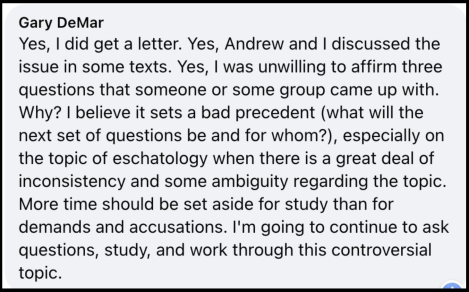
February 28, 2023
1 THESS. 4 AND THE OLIVET DISCOURSE
PMW 2023-017 by Kenneth L. Gentry, Jr.
Recently a reader responded to one of my articles with a lengthy question. Rather than quickly answering it and moving on, I have decided to provide an answer in a full article. Perhaps later I will deal with it even more thoroughly in a series.
MY READER WROTE:
I’m not advocating for full preterism, but reading Mt. 24 and 1 Thess. 4-5 side-by-side (noted below) I can see a 1st century fulfillment in both places. To me, the only real clear passage that speaks to the end of time as we know it is, 1 Cor. 15:24.
Further, I am of the opinion that all of Mt. 24/25 was fulfilled in AD 70 as well, or is in the PROCESS of being fulfilled (an ONGOING reality). Further to the point, in Matthew 25, the bridegroom of the wise and foolish virgins returns to the same people he left. Similarly, the parable of the talents tells us the lord of the servants returned “after a long time” to the same people he left. “Now all these things happened to them as examples, and they were written for our admonition, upon whom the ends of the ages have come.” 1 Cor. 10:11.
Lastly, there are just too many similarities in Mt. 16:27-28; Mt. 25:31 and Rev 22:12 to think one might apply to AD 70 and another to the end of time, etc. The reference to Christ separating the sheep from the goats in Mt. 25:31 may be a typological fulfillment of Deut. 27:12 (blessing) and Deut. 27:13 (cursed). The separation of tribes unto Mt. Gerizim (blessed) and Mt. Ebal (cursed) took place towards the beginning of their entrance into the “physical” promised land (not the end). Christ separating sheep (blessed) and goats (cursed) could very well have started towards the beginning of the “spiritual” promised land. Christ, indeed, redeemed us from this curse, Gal. 3:13, and is therefore “gathering” the elect unto himself from the start of his reign until his last enemy is under foot. I.e., until the final judgment.
Thank you for allowing me to opine. I am simply a layman in the body of Christ trying to sort it all out. If I’m way off base, please feel free to correct me.
I greatly respect your work, Dr. Gentry. Blessings unto you.
More on Mt. 24 and 1 Thess. 4 (I read this elsewhere, but don’t recall the author to give proper credit.)
Matthew 24 – Fulfilled in AD 70 1 Thessalonians 4-5 Fulfilled in AD 70
1. Christ comes from heaven (24:30) 1. Christ comes from heaven (4:16)
2. With archangelic voice (24:31) 2. With archangelic voice (4:16)
3. With God’s trumpet call (24:31) 3. With God’s trumpet call (4:16)
4. Gathered/Caught to Christ (24:31) 4. Gathered/Caught to Christ (4:17)
5. Believers meet Christ in clouds (24:30) 5. Believers meet Christ in clouds (4:17)
6. Use of contemporary “you” and parousia to be fulfilled in their contemporary generation (24:34) 6. Use of contemporary “we” and parousia expected while some are still alive (4:15)
7. Exact time unknown (24:36) 7. Exact time unknown (5:1-2)
8. Christ comes like a thief (24:43) 8. Christ comes like a thief (5:2)
9. Unbelievers caught unaware (37-39) 9. Unbelievers caught unaware (5:3)
10. Birth pains (24:8 – fulfilled in AD 70) 10. Birth pains (5:3)
11. Believers are not deceived (24:43) 11. Believers are not deceived (5:4-5)
12. Believers told to be watchful (24:42) 12. Believers told to be watchful (5:6)
13. Exhortation against drunkenness (24:49) 13. Exhortation against drunkenness (5:7)
14. The Day, Sunlight (24:27, 36-38) 14. The Day, sons of light, sons of day

He Shall Have Dominion
(paperback by Kenneth Gentry)
A classic, thorough explanation and defense of postmillennialism (600+ pages). Complete with several chapters answering specific objections.
See more study materials at: www.KennethGentry.com
MY ME ANSWERED:
We must be careful when we lay Scriptures side-to-side in order to “connect the dots.” Scripture has a great repository of images that are re-useable in divergent situations.
For instance, we find several “day of the Lord” events in the OT that speak of different historical judgments (e.g., Isa. 24:21–22; Zeph. 1:14–18; Isa. 13:4–6, 9–11; Jer. 46:10; Eze. 30:3–4; Joel 3:12–14). In many respects they are similar in wording (lexicography) and in effect (divine judgment). Nevertheless they refer to different events. Similarity does not entail identity.
Perhaps the classic example of this interpretive concept is the two temple cleansings by Jesus. Though they look identical we know that one occurs at the beginning of his ministry (John 2:11; cp. vv. 13–22), while the other (Matt. 21:12–13) occurs at its end (Matt. 21:1–10). Thus, they are separated by over three years. This prophetic judgment sign was well placed at both the beginning and end of his ministry for theological reasons.
Again, it is so important that we understand that similarity does not entail identity. A failure to recognize this has led scores of people to adopt hyperpreterism by employing their “connect-the-dots” exegetical game. Just because two sets of images are similar does not mean they apply to the same historical event.
Furthermore, the AD 70 judgment was a part of a long line of “day of the Lord” events that pointed to a future, consummate day of the Lord, i.e., Christ’s second coming and the final judgment which end history, not just some earthly kingdom. The exact date of the coming of the Lord in final judgment is not known, but the actual fact of his coming at the end is well-prophesied in Scripture. A serious problem with the hyperpreterist’s theological system of an unending (i.e., un-renewed) world and continuing our current as-is history is that their worldview cannot explain God’s purpose for the world as a whole. Sad. In fact, effectively they do not have a “world” view.
Thine Is the Kingdom
(ed. by Ken Gentry)
Contributors lay the scriptural foundation for a biblically-based, hope-filled postmillennial eschatology, while showing what it means to be postmillennial in the real world.
See more study materials at: www.KennethGentry.com
In addition, orthodox preterists (and other interpretive schools!) recognize that the Olivet prophecy lies behind Paul’s imagery in 1 Thessalonians 4–5. This is because the two events to which they refer are related. They are related conceptually, not historically. One points beyond itself to the other: AD 70 is a distant adumbration of the Final Judgment.
Besides, several of the comparisons you make between 1 Thessalonians 4 and Matthew 24–25 are simply common, stock-in-trade images that can occur at any number of divine judgments: the archangel voice; unknown time; coming as a thief; birth pains; watchfulness; exhortation against drunkenness, and so forth.
I would argue that the first part of Olivet speaks of issues occurring in that generation (Matt. 24:34) in the first century (Matt. 24:4–34). The disciples were confused regarding Jesus’ prophecy of the temple’s destruction in v. 2, which leads to their wrong-headed supposition that the temple’s destruction entailed the end of the world (v. 3). This was due to three issues:
(1) Inter-testamental Judaism did not recognize that the Messiah was to suffer and die (as we see in the apocalyptic literature between 200 BC and AD 200). And (2) it held that when the Messiah came, he would overthrow the enemy. Thus, there was the anticipation “in the air,” as it were, that Jesus would do so (e.g., John 6:15). Consequently, the Jews, like John the Baptist (Matt. 11:2–3), were confused about what Jesus was doing — as they often were, especially regarding his death (Matt. 16:22) and resurrection (John 22:8–9). And furthermore, (3) first-century Jews believed that the temple would last to the end of history (see Philo, Spec. 1:76; Josephus, J.W. 5:11:2 §459; Sib. Or. 5:420–23).
MY ME CONCLUDING
So, in summary: 1 Thessalonians 4 looks like Matthew 24 for two basic reasons: (1) both are dealing with divine judgments that can employ the same stock-in-trade language; and (2) Paul uses the Olivet Discourse as his backdrop in pointing ahead to what Jesus was ultimately referring to: the final judgment (Matt. 25:31–46).
THE TWO AGES AND OLIVET
I am currently researching a study of the Two-Age structure of redemptive history. My starting point is based on the disciples’ questions to Jesus in Matthew 24:3. Much confusion reigns among those unacquainted over the Two-Age analysis of history that was promoted by Jesus and by Paul. The Two Ages are not the old covenant and the new covenant, but world history since the fall and the consummate order following the Second Coming and the Final Judgment.
If you would like to support me in my research, I invite you to consider giving a tax-deductible contribution to my research and writing ministry: GoodBirth Ministries. Your help is much appreciated!
Click on the following images for more information on these studies:
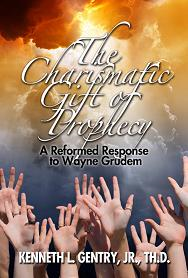
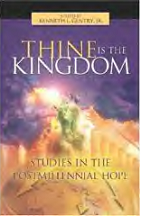
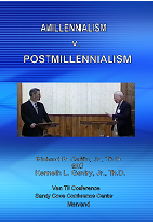
February 24, 2023
THE SPIRIT IN THE RESURRECTION
PMW 2023-016 Geerhardus Vos 
Gentry note:
This insightful article is a section of a longer study by Geerhardus Vos which is found in Richard B. Gaffin, Jr. Redemptive History and Biblical Interpretation available at P & R Publishing. Its original title is “Paul’s Eschatological Concept of the Spirit.” This is slightly edited to break up long sentences and paragraphs into smaller sizes and to replace Greek characters with English transliterations
Vos’ article:
In 2 Corinthians 5:5 Paul declares that God has prepared him for the eternal state in the new heavenly body, as may be seen from this that he gave him the arrbon to pneumatos. The arrabon consists in the Spirit. “Of the Spirit” is epexegetical, just as in Galatians 3:14 the epaggelia to pneumatos to pneumatos means the promised thing consisting in the Spirit. But the Spirit possesses this significance of an arrabon because it is a preliminary installment of what in its fullness will be received hereafter. The analogous conception of the aparche to pneumatos, Romans 8:23, proves this. The figure of the arrabon itself implies this relation no less than that of the aparche for it means “money which in purchases is given as a pledge that the full amount will be subsequently paid.”
In this instance, therefore, the Spirit is viewed as pertaining specifically to the future life. In fact, as constituting the substantial make-up of this life. And the present possession of the Spirit by the believer is regarded in the light of an anticipation. The Spirit’s proper sphere is according to this the world to come. From there he projects himself into the present, and becomes a prophecy of himself in his eschatological operation.

Greatness of the Great Commission (by Ken Gentry)
An insightful analysis of the full implications of the great commission. Impacts postmillennialism as well as the whole Christian worldview.
See more study materials at: www.KennethGentry.com
Undoubtedly more statements to the same effect would be found. Except for the circumstance that it was more natural for the Apostle to express the idea in connection with the eschatological life of Christ, as already a present reality, than in connection with the eschatological state of believers, which still lies in the future.
We, therefore, inquire in the second place to what extent eschatological side-lights fall on the resurrection and the resurrection-life of Christ. We begin with Romans 1:4. Here, we read that Christ was horistheis huios theou en dunamei kata pneuma hagiosunes ex anastaseos nekron. The statement stands in close parallelism to verse 3 tou genomenou ek spermatos Dauid kata sarka. The following members correspond to each other in the two clauses:
Rom. 1:3 and Rom. 1:4
genomenos = oristheis
Kata sarka = kata pneuma hagiosunes
ek spermatos Dauid = ex anastaseos nekron
The reference is not to two coexisting sides in the constitution of the Saviour. Rather it is to two successive stages in his life. There was first a genesthai kata sarka, then a horisthenai kata pneuma. The two prepositional phrases have adverbial force. They describe the mode of the process, yet so as to throw emphasis rather on the result than on the initial act: Christ came into being as to his sarkic (“fleshly”) existence, and he was introduced by horismos (“declared”) into his pneumatic existence.
The horizein (“declared”) is not an abstract determination, but an effectual appointment. Paul obviously avoids the repetition of genomenou (“came, was born”) not for rhetorical reasons only. Rather, because it might have suggested, even before the reading of the whole sentence could correct it, a misunderstanding. The misunderstanding that at the resurrection the divine sonship of Christ as such first originated. Whereas the Apostle merely meant to affirm this late temporal origin of the divine sonship en dunamei (“in power”), the sonship as such reaching back into the state of pre-existence.
By the twofold kata (“according to”) the mode of each state of existence is contrasted; by the twofold ek (“from”) the origin of each. Thus the existence kata sarka (“according to the flesh”) originated “from the seed of David.” Whereas the existence kata pneuma (according to the Spirit”) originated “out of resurrection from the dead.”
The point of importance for our present purpose lies in this last contrast. How can resurrection from the dead be the counterpart of an issue from the seed of David? There are in the Pauline world of thought but two answers to this question, and both will have to be combined in the present instance.
Have We Missed the Second Coming:
A Critique of the Hyper-preterist Error
by Ken Gentry
This book offers a brief introduction, summary, and critique of Hyper-preterism. Don’t let your church and Christian friends be blindfolded to this new error. To be forewarned is to be forearmed.
For more Christian educational materials: www.KennethGentry.com
First, the resurrection is to Paul the beginning of a new status of sonship. Hence, as Jesus derived his sonship kata sarka (“according to the flesh”) from the seed of David, he can be said to have derived his divine-sonship-in-power from the resurrection. The implication is that the one working in the resurrection is God: it is his seed that supernaturally begets the higher sonship. And in all probability the Genitive hagiosunes (“of holiness”) which is added to “Spirit,” is meant as a designation of God from the point of view of his specific deity, sharply distinguishing him as such from David.
Still, all this might have been expressed by Paul writing “effectually appointed according to the Spirit of Holiness the Son in power of God who raises the dead.” That, instead of doing this, he writes ek anastaseos nekron (“by resurrection of the dead”) must be explained from a second motive. He wished to contrast the resurrection-process in a broad generic way with the processes of this natural life. The resurrection is characteristic of the beginning of a new order of things, as sarkic birth is characteristic of an older order of things. Thus, what stands before the Apostle’s mind is the contrast between the two aeons, for it was a familiar thought to the Jewish theology that the future aeon has its characteristic beginning in the great resurrection-act.
This also will explain why in ek anastaseos nekron both nouns are anarthrous [without definite articles]. Paul is not thinking of the resurrection of Christ as an event. Rather to what happened to Christ in its generic qualitative capacity, as an epoch partaking of a strictly eschatological nature. From resurrection-beginnings, from an eschatological genesis dates the pneumatic state of Christ’s glory which is described as a sonship of God en dunamei.
In 1 Corinthians 15:42–50 the Apostle contrasts the two bodies which belong to the pre-eschatological and the eschatological state respectively. The former is characterized as psuchikon, the latter as pneumatikon. Here therefore, as regards the body, the eschatological state is the state in which the Pneuma rules, impressing upon the body its threefold characteristic of aphtharsia [“incorruptible”], doxa [“glory”], dunamis [“power”] (vv. 42, 43). And over against this, and preceding it, stands the “psychical” body characterized by phthora [“corruptible”], atimia [“dishonorable”], and astheneia [“weakness”].
The proximate reference is to the body and the contrast is between the body in the state of sin and the body in the resurrection-state. It will be noticed, however, that in verses 45 and 46 the Apostle generalizes the antithesis so that it no longer concerns the body exclusively, but concerns the whole state of man. And at the same time, it enlarges the one term of the contrast, that relating to the pre-eschatological period, so as to make it cover no longer the reign of sin, but the order of things established in creation.
To pneumatikon and to psuchikon in verse 46 are generalizing expressions, after which it would be a mistake to supply soma [“body”]. They designate the successive reign of two comprehensive principles in history, two successive world-orders, a first and a second creation, beginning each with an Adam of its own. Even apart from sin these two stand related to each other, as the natural and the supernatural.
This is expressed by the contrast ek ges [“from earth”] and ex ouranou [“from heaven”]. When it is said that the second man is from heaven, this has nothing to do with the original provenience of Christ from heaven. The ex ouranou does not imply a “coming” from heaven, no more than the ek ges implies a coming of Adam from the earth at the first creation. To refer ex ouranou to the coming of Christ out of the state of preëxistence at his incarnation would make Paul contradict himself, for it would reverse the order insisted upon in verse 46. That is, not the pneumatic is first, but the psychical first.

He Shall Have Dominion
(paperback by Kenneth Gentry)
A classic, thorough explanation and defense of postmillennialism (600+ pages). Complete with several chapters answering specific objections.
See more study materials at: www.KennethGentry.com
Besides this, it would make the pneumatic the constitutive principle of the Person of Christ before the incarnation, of which there is no trace elsewhere in Paul. The phrase ex ouranou simply expresses that Christ after a supernatural fashion became “the second man” at the point marked by epeita [“then”]. A “becoming” is affirmed of both Adams, the second as well as the first, for the egeneto in verse 45 belongs to both clauses. How far in either case the subject of which this is affirmed existed before in a different condition is not reflected upon.
The whole tenor of the discussion compels us to think of the resurrection as the moment at which to pneumatikon entered, the second man supernaturally appeared, in the form of to pneumatikon zoopoioun [“a quickening spirit”] inaugurated the eschatological era. But besides identifying the eschatological and the pneumatic, our passage is peculiar in that it most closely identifies the Spirit with Christ. In the preceding passages the Spirit, who works and bears the future life was the Spirit of God. Here it is not merely the Spirit of Christ, but the Spirit which Christ became. And being thus closely and subjectively identified with the risen Christ the Spirit imparts to Christ the life-giving power which is peculiarly the Spirit’s own: the second Adam became not only pneuma zon [“living Spirit”] but pneuma zoopoioun [“life giving Spirit”]. This is of great importance for determining the relation to eschatology of the Christ-worked life in believers, as we shall soon have occasion to show.
February 21, 2023
VOS ON THE RESURRECTION OF BELIEVERS
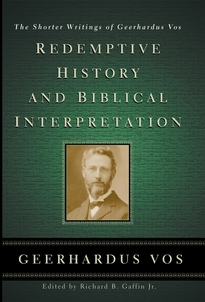 Gentry note:This insightful article is a section of study by Geerhardus Vos which is found in Richard Gaffin, Redemptive History and Biblical Interpretation available at P & R Publishing. This is slightly edited to break up long sentences and paragraphs into smaller sizes.Vos’ study:The resurrection of believers bears a twofold aspect. On the one hand it belongs to the forensic side of salvation. On the other hand it belongs to the pneumatic transforming side of the saving process. Of the former, traces appear only in the teaching of Jesus (Matthew 5:9; 22:29–32; Luke 20:35, 36). Paul clearly ascribes to the believer’s resurrection a somewhat similar forensic significance as to that of Christ (Romans 8:10, 23; 1 Corinthians 15:30–32, 55–58).Far more prominent with Paul is, however, the other, the pneumatic interpretation. Both the origin of the resurrection life and the continuance of the resurrection state are dependent on the Spirit (Romans 8, 10, 11; 1 Corinthians 15:45–49; Galatians 6:8). The resurrection is the climax of the believer’s transformation (Romans 8:11; Galatians 6:8). This part ascribed to the Spirit in the resurrection is not to be explained from what the Old Testament teaches about the Spirit as the source of physical life, for to this the New Testament hardly ever refers. It is rather to be explained as the correlate of the general Pauline principle that the Spirit is the determining factor of the heavenly state in the coming eon.
Understanding the Olivet Discourse
(by Ken Gentry)
Gentry note:This insightful article is a section of study by Geerhardus Vos which is found in Richard Gaffin, Redemptive History and Biblical Interpretation available at P & R Publishing. This is slightly edited to break up long sentences and paragraphs into smaller sizes.Vos’ study:The resurrection of believers bears a twofold aspect. On the one hand it belongs to the forensic side of salvation. On the other hand it belongs to the pneumatic transforming side of the saving process. Of the former, traces appear only in the teaching of Jesus (Matthew 5:9; 22:29–32; Luke 20:35, 36). Paul clearly ascribes to the believer’s resurrection a somewhat similar forensic significance as to that of Christ (Romans 8:10, 23; 1 Corinthians 15:30–32, 55–58).Far more prominent with Paul is, however, the other, the pneumatic interpretation. Both the origin of the resurrection life and the continuance of the resurrection state are dependent on the Spirit (Romans 8, 10, 11; 1 Corinthians 15:45–49; Galatians 6:8). The resurrection is the climax of the believer’s transformation (Romans 8:11; Galatians 6:8). This part ascribed to the Spirit in the resurrection is not to be explained from what the Old Testament teaches about the Spirit as the source of physical life, for to this the New Testament hardly ever refers. It is rather to be explained as the correlate of the general Pauline principle that the Spirit is the determining factor of the heavenly state in the coming eon.
Understanding the Olivet Discourse
(by Ken Gentry)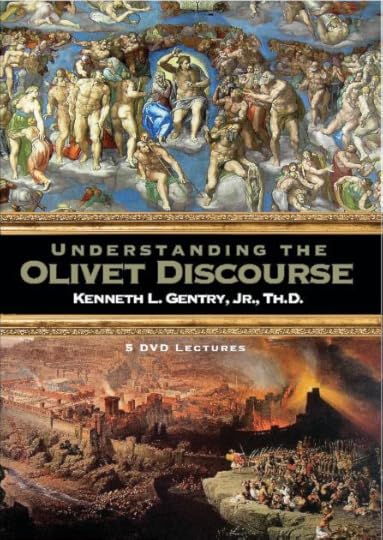 This 5 DVD lecture set was filmed at a Bible Conference in Florida. It explains the entire Olivet Discourse in Matt. 24–25 from the (orthodox) preterist perspective. See more study materials at: www.KennethGentry.com This pneumatic character of the resurrection also links together the resurrection of Christ and that of the believer. This idea is not yet found in the Synoptics; it finds expression in John 5:22–29; 11:25; 14:6, 19. In early apostolic teaching a trace of it may be found in Acts 4:2. With Paul it appears from the beginning as a well-established principle. The continuity between the working of the Spirit here and His part in the resurrection does not, however, lie in the body. The resurrection is not the culmination of a pneumatic change which the body in this life undergoes. There is no preformation of the spiritual body on earth. Romans 8:10, 11; 1 Corinthians 15:49; 2 Corinthians 5:1, 2; Philippians 3:12 positively exclude this, and 2 Corinthians 3:18; 4:7–18 do not require it.The glory into which believers are transformed through the beholding (or reflecting) of the glory of Christ as in a mirror is not a bodily but inward glory, produced by illumination of the gospel. And the manifestation of the life of Jesus in the body or in the mortal flesh refers to the preservation of bodily life in the midst of deadly perils.Equally without support is the view that at one time Paul placed the investiture with the new body immediately after death. It has been assumed that this, together with the view just criticized, marks the last stage in a protracted development of Paul’s eschatological belief. The initial stage of this process is found in 1 Thessalonians: the resurrection is that of an earthly body. The next stage is represented by 1 Corinthians: the future body is pneumatic in character, although not to be received until the parousia. The third stage removes the inconsistency implied in the preceding position between the character of the body and the time of its reception, by placing the latter at the moment of death (2 Corinthians, Romans, Colossians). And by an extreme flight of faith the view is even approached that the resurrection body is in process of development now (Teichmann, Charles). This scheme has no real basis of fact.First Thessalonians does not teach an unpneumatic eschatology (compare 4:14, 16). The second stage given is the only truly Pauline one, nor can it be shown that the apostle ever abandoned it. For the third position named finds no support in 2 Corinthians 5:1–10; Romans 8:19; Colossians 3:4.The exegesis of 2 Corinthians 5:1–10 is difficult and cannot here be given in detail. Our understanding of the main drift of the passage, put into paraphrase, is as follows: we feel assured of the eternal weight of glory (4:17). This is because we know that we shall receive, after our earthly tent-body shall have been dissolved (aorist subjunctive), a new body, a supernatural house for our spirit, to be possessed eternally in the heavens.A sure proof of this lies in the heightened form which our desire for this future state assumes. For it is not mere desire to obtain a new body, but specifically to obtain it as soon as possible, without an intervening period of nakedness, i.e. of a disembodied state of the spirit. Such would be possible, if it were given us to survive till the parousia. For in that case we would be clothed upon with our habitation from heaven (= supernatural body), the old body not having to be put off first before the new can be put on. But the new body being superimposed upon the old, so that no “unclothing” would have to take place first, what is mortal simply being swallowed up of life (5:2, 4).And we are justified in cherishing this supreme aspiration, since the ultimate goal set for us in any case, even if we should have to die first and to unclothe and then to put on the new body over the naked spirit, since the ultimate goal, I say, excludes under all circumstances a state of nakedness at the moment of the parousia (5:3).Since, then, such a new embodied state is our destiny in any event, we justly long for that mode of reaching it which involves least delay and least distress and avoids intermediate nakedness. (This on the reading in 5:3 of ei ge kai endusamenoi ou gumnoi heurethesometha [“If indeed also being clothed, not naked we shall be found”]. If the reading ei ge kai ekdusamenoi be adopted the rendering of 5:3 will have to be: “If so be that also having put off (i.e. having died), we shall not at the end be found naked.” If eiper kai ekdusamenoi be chosen it will be: “Although even having put off (i.e. having died) we shall not at the end be found naked.” These other readings do not materially alter the sense.)The understanding of the passage will be seen to rest on the pointed distinction between being “clothed upon,” change at the parousia without death (5:2, 4), to be “unclothed,” loss of the body in death with nakedness resulting (5:4), and “being clothed,” putting on of the new body after a state of nakedness (5:3). Interpreted as above, the passage expresses indeed the hope of an instantaneous endowment with the spiritual body immediately after this life, but only on the supposition that the end of this life will be at the parousia. This would not be for the case that death should intervene before, which latter possibility is distinctly left open.In Romans 8:19 what will happen at the end to believers is called a “revealing of the sons of God.” This is not because their new body existed previously, but because their status as sons of God existed before, and this status will be revealed through the bestowal upon them of the glorious body.Colossians 3:3 speaks of a “life … hid with Christ in God,” and of the “manifestation” of believers with Christ in glory at the parousia. But “life” does not imply bodily existence, and while the “manifestation” at the parousia presupposes the body, it does not imply that this body must have been acquired long before, as is the case with Christ’s body.In conclusion it should be noted that there is ample evidence in the later epistles that Paul continued to expect the resurrection body at the parousia (2 Corinthians 5:10; Philippians 3:20, 21).
GREAT TRIBULATION: PAST OR FUTURE?
By Thomas Ice v. Ken Gentry
This 5 DVD lecture set was filmed at a Bible Conference in Florida. It explains the entire Olivet Discourse in Matt. 24–25 from the (orthodox) preterist perspective. See more study materials at: www.KennethGentry.com This pneumatic character of the resurrection also links together the resurrection of Christ and that of the believer. This idea is not yet found in the Synoptics; it finds expression in John 5:22–29; 11:25; 14:6, 19. In early apostolic teaching a trace of it may be found in Acts 4:2. With Paul it appears from the beginning as a well-established principle. The continuity between the working of the Spirit here and His part in the resurrection does not, however, lie in the body. The resurrection is not the culmination of a pneumatic change which the body in this life undergoes. There is no preformation of the spiritual body on earth. Romans 8:10, 11; 1 Corinthians 15:49; 2 Corinthians 5:1, 2; Philippians 3:12 positively exclude this, and 2 Corinthians 3:18; 4:7–18 do not require it.The glory into which believers are transformed through the beholding (or reflecting) of the glory of Christ as in a mirror is not a bodily but inward glory, produced by illumination of the gospel. And the manifestation of the life of Jesus in the body or in the mortal flesh refers to the preservation of bodily life in the midst of deadly perils.Equally without support is the view that at one time Paul placed the investiture with the new body immediately after death. It has been assumed that this, together with the view just criticized, marks the last stage in a protracted development of Paul’s eschatological belief. The initial stage of this process is found in 1 Thessalonians: the resurrection is that of an earthly body. The next stage is represented by 1 Corinthians: the future body is pneumatic in character, although not to be received until the parousia. The third stage removes the inconsistency implied in the preceding position between the character of the body and the time of its reception, by placing the latter at the moment of death (2 Corinthians, Romans, Colossians). And by an extreme flight of faith the view is even approached that the resurrection body is in process of development now (Teichmann, Charles). This scheme has no real basis of fact.First Thessalonians does not teach an unpneumatic eschatology (compare 4:14, 16). The second stage given is the only truly Pauline one, nor can it be shown that the apostle ever abandoned it. For the third position named finds no support in 2 Corinthians 5:1–10; Romans 8:19; Colossians 3:4.The exegesis of 2 Corinthians 5:1–10 is difficult and cannot here be given in detail. Our understanding of the main drift of the passage, put into paraphrase, is as follows: we feel assured of the eternal weight of glory (4:17). This is because we know that we shall receive, after our earthly tent-body shall have been dissolved (aorist subjunctive), a new body, a supernatural house for our spirit, to be possessed eternally in the heavens.A sure proof of this lies in the heightened form which our desire for this future state assumes. For it is not mere desire to obtain a new body, but specifically to obtain it as soon as possible, without an intervening period of nakedness, i.e. of a disembodied state of the spirit. Such would be possible, if it were given us to survive till the parousia. For in that case we would be clothed upon with our habitation from heaven (= supernatural body), the old body not having to be put off first before the new can be put on. But the new body being superimposed upon the old, so that no “unclothing” would have to take place first, what is mortal simply being swallowed up of life (5:2, 4).And we are justified in cherishing this supreme aspiration, since the ultimate goal set for us in any case, even if we should have to die first and to unclothe and then to put on the new body over the naked spirit, since the ultimate goal, I say, excludes under all circumstances a state of nakedness at the moment of the parousia (5:3).Since, then, such a new embodied state is our destiny in any event, we justly long for that mode of reaching it which involves least delay and least distress and avoids intermediate nakedness. (This on the reading in 5:3 of ei ge kai endusamenoi ou gumnoi heurethesometha [“If indeed also being clothed, not naked we shall be found”]. If the reading ei ge kai ekdusamenoi be adopted the rendering of 5:3 will have to be: “If so be that also having put off (i.e. having died), we shall not at the end be found naked.” If eiper kai ekdusamenoi be chosen it will be: “Although even having put off (i.e. having died) we shall not at the end be found naked.” These other readings do not materially alter the sense.)The understanding of the passage will be seen to rest on the pointed distinction between being “clothed upon,” change at the parousia without death (5:2, 4), to be “unclothed,” loss of the body in death with nakedness resulting (5:4), and “being clothed,” putting on of the new body after a state of nakedness (5:3). Interpreted as above, the passage expresses indeed the hope of an instantaneous endowment with the spiritual body immediately after this life, but only on the supposition that the end of this life will be at the parousia. This would not be for the case that death should intervene before, which latter possibility is distinctly left open.In Romans 8:19 what will happen at the end to believers is called a “revealing of the sons of God.” This is not because their new body existed previously, but because their status as sons of God existed before, and this status will be revealed through the bestowal upon them of the glorious body.Colossians 3:3 speaks of a “life … hid with Christ in God,” and of the “manifestation” of believers with Christ in glory at the parousia. But “life” does not imply bodily existence, and while the “manifestation” at the parousia presupposes the body, it does not imply that this body must have been acquired long before, as is the case with Christ’s body.In conclusion it should be noted that there is ample evidence in the later epistles that Paul continued to expect the resurrection body at the parousia (2 Corinthians 5:10; Philippians 3:20, 21).
GREAT TRIBULATION: PAST OR FUTURE?
By Thomas Ice v. Ken Gentry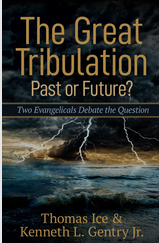 Kregel Publications debate book on the nature and timing of “the great tribulation.” Both sides thoroughly cover the evidence they deem necessary for understanding “the great tribulation.” They then carefully interact with each other. Helpful introduction to the debate between futurism and preterism.See more study materials at: www.KennethGentry.com
Kregel Publications debate book on the nature and timing of “the great tribulation.” Both sides thoroughly cover the evidence they deem necessary for understanding “the great tribulation.” They then carefully interact with each other. Helpful introduction to the debate between futurism and preterism.See more study materials at: www.KennethGentry.com
February 17, 2023
GNOSTICISM ARISING
PMW 2023-014 by Kenneth L. Gentry, Jr.
Sadly, gnosticism is arising within the evangelical church, despite Paul’s refutation of it in 1 Corinthians.
In his incarnation Jesus entered history as the Last Adam (1 Cor. 15:45), becoming a true and full human, body and soul (John 1:14). Thus, he came into this world as a whole person, body and soul (Heb. 10:5). And he died for our sins as a whole person, body and soul (Heb. 2:14). Then he ascended into heaven, body and soul (Acts 1:9–11), where he now lives, body and soul (Col. 2:9).
And just as sinners are judged for their sins in their whole person, body and soul (Matt. 10:28), so shall the righteous receive full redemption at the resurrection, in body and soul (Rom. 8:23). We are not angels, spirit beings designed for living in a spirit environment (Heb. 1:14; cp. Luke 24:39). Rather, we are humans composed of body and soul designed for living in a physical environment in history (Gen. 2:7) just as we will ultimately experience in eternity in a new earth (Rom. 8:19–22).
If you have a friend playing with the fire of hyperpreterism, help them before they get burned and their Christian witness goes up in smoke. Help them to extricate themselves before they begin denying foundational elements of the Christian faith (such as the resurrection, Heb. 5:12–6:2) and even begin denying Christ’s continuing incarnational physical form (Col. 2:9).
Have We Missed the Second Coming:
A Critique of the Hyper-preterist Error
by Ken Gentry
This book offers a brief introduction, summary, and critique of Hyper-preterism. Don’t let your church and Christian friends be blindfolded to this new error. To be forewarned is to be forearmed.
For more Christian educational materials: www.KennethGentry.com
Kenneth L. Gentry Jr.'s Blog
- Kenneth L. Gentry Jr.'s profile
- 85 followers



